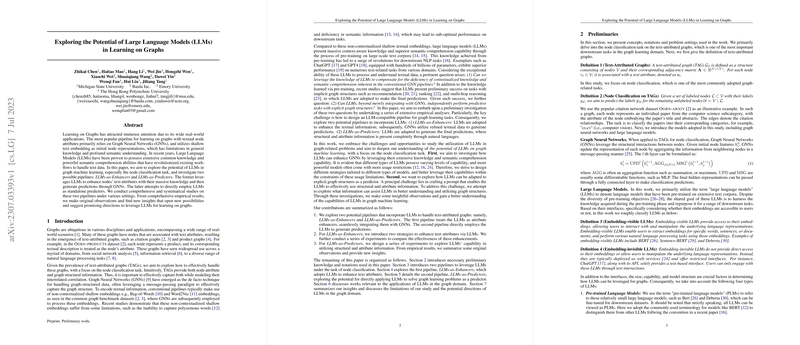Insightful Overview of the Paper: Exploring the Potential of LLMs in Learning on Graphs
The paper presents a thorough investigation into the applications of LLMs in graph machine learning, particularly focusing on the node classification task in text-attributed graphs (TAGs). Traditional methods for learning on such graphs typically rely on Graph Neural Networks (GNNs) combined with shallow text embeddings, which often fall short in capturing deep semantic understanding. Given the prowess of LLMs in processing natural language and their extensive pre-trained knowledge, the authors propose two novel pipelines: LLMs-as-Enhancers and LLMs-as-Predictors, and evaluate their efficacy in overcoming the limitations of existing methods.
LLMs-as-Enhancers
The LLMs-as-Enhancers approach leverages LLMs to improve the quality of node textual attributes through two methods: feature-level and text-level enhancements. The feature-level enhancement encodes text attributes using embedding-visible LLMs before feeding them to GNNs, while the text-level enhancement involves generating enhanced text attributes via LLMs with text outputs. Significant findings include:
- Deep Sentence Embedding Models: These, like Sentence-BERT, provide competitive embeddings in terms of both efficiency and downstream performance across various datasets. This effectiveness is attributed to their robustness despite being pre-trained without structural data.
- Limitations of Fine-tuning: Fine-tuned models, employed in low-labeling-rate conditions, tend to perform inadequately, suggesting that without sufficient data, the inherent transferability of these models might be restricted compared to context-aware pooling exemplars.
- LLMs as Textual Augmenters: LLMs, utilizing a cascading structure with GNNs, generate augmented textual attributes that result in performance boosts, pointing towards the robustness of using additional contextual text information.
LLMs-as-Predictors
Exploring LLMs as standalone predictors, where they handle prediction tasks without depending on GNNs, sheds light on LLM capabilities beyond text comprehension, recognizing the graph structures:
- Preliminary Effectiveness: The LLMs demonstrated commendable zero-shot performance in certain datasets, particularly when conventional GNNs' assistance was limited, especially in node classification.
- Evaluation Challenges: Highlighted are issues such as the potential mismatch between annotated labels and LLM-predicted labels being entirely reasonable due to the inherent annotation biases.
- Chain-of-thought Inapplicability: A peculiar observation that chain-of-thought prompting, usually beneficial for reasoning tasks, does not improve results. This indicates the necessity of refining input prompts for graph-based tasks where LLM reasoning paths may deviate.
Practical and Theoretical Implications
The paper’s findings suggest several implications for future work in AI and machine learning. Using LLMs to amplify TAGs offers an efficient integration of linguistic information with structural graph data, potentially transforming applications across social networks, citation analysis, and beyond. Additionally, the identified limitations and potential biases in LLM-driven predictions advocate for a considerate approach in expanding their usability—emphasizing correct prompt engineering and enhancing data poses a direction worth exploring.
Future Prospects and Considerations
This research paves the way for novel AI developments, particularly in the seamless aim to enhance graph learning frameworks. The robust incorporation or standalone utility of LLMs introduces revolutionary facets of integrating large-scale pre-trained knowledge, aiming to better bridge the gap between language processing and graph analysis. Future work could explore automatic prompt engineering algorithms or explore hybrid models that dynamically adapt the contributions of LLMs during the learning process. Thus, the paper distinctly contributes to both the theoretical foundation and application precision of employing LLMs in graph machine learning.
